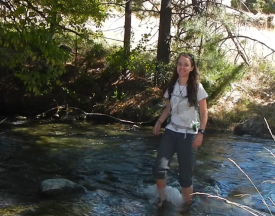By Randi Bowman, Undergraduate, Lewis-Clark State College
Every body of water has a story to tell, and multiple languages with which to tell it. The story is told in the benthic sediments, the suspended metals and chemicals, the turbidity, and in living organisms like fish, aquatic vegetation, and macroinvertebrates. My current research, funded in part by the 2016 WALPA Undergraduate Scholarship, focuses on telling the story of the Snake River drainage from the perspective of aquatic macroinvertebrates. Using abundance data and tolerance values, I will be able to take a snapshot of its ecological health and possible future trajectory.
From mining to agriculture, current and past land uses have likely impacted watersheds in the Snake River drainage and their ecological health, leaving behind altered ecosystems. The Grande Ronde River, Wallowa River, Imnaha River, and Tammany Creek were chosen for analysis, and all have a history of mining and agricultural land use. Macroinvertebrates are ideal organisms for studying the effects of pollution-contributing land uses on stream health for multiple reasons, perhaps the most obvious being their geographically ubiquitous and static nature. Macroinvertebrates also have varied life spans, diverse feeding habits and known pollution tolerances. Their reliance on water for survival and proliferation means that they are often the first indicators of pollution in streams.
By sampling and comparing macroinvertebrate assemblages near a river’s headwaters and its mouth, we can determine whether pollution from agricultural and mining land uses is significant. Threats to macroinvertebrate diversity include habitat loss, sedimentation, and chemical pollution. These are also threats to the overall biodiversity of aquatic ecosystems and to hunters, fishers, and stewards who rely on that biodiversity for recreation. Through this research we will be able to determine the overall quality of aquatic ecosystems in the Snake River drainage and therefore inform future management decisions involving those watersheds.










